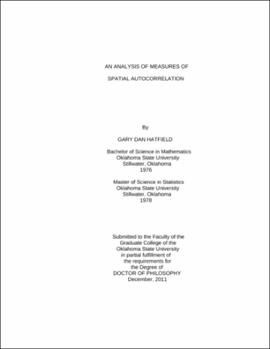| dc.contributor.advisor | Goad, Carla Lynn | |
| dc.contributor.author | Hatfield, Gary Dan | |
| dc.date.accessioned | 2013-11-26T08:28:12Z | |
| dc.date.available | 2013-11-26T08:28:12Z | |
| dc.date.issued | 2011-12 | |
| dc.identifier.uri | https://hdl.handle.net/11244/7020 | |
| dc.description.abstract | Scope and Method of Study: Many fields of study are interested in the spatial relationship of data. Spatial autocorrelation is used to measure the strength of spatial relationships. Current measures of local spatial autocorrelation were developed by Anselin, Getis, and Ord. These include Ii, ci, Gi , and Gi*. A limitation of these measures is the difficulty of their interpretation. Researchers would benefit from a statistic that is quickly interpreted without additional analysis or standardization. This research involves the development and analysis of measures of local spatial autocorrelation which are constrained to the interval [-1, +1]. This is the range that is typically used for measures of correlation. When data are from a multivariate normal distribution, the proposed measures have a twice-folded Cauchy distribution which has finite moments. Its parameters are derived as functions of the multivariate normal parameters. Simulations were utilized to investigate size and power, using randomization tests, of two proposed measures and four existing measures. The model used for this study has stationary mean and heterogeneous variance-covariance matrices. Variables investigated for each of six local measures are number of regions in a study area, connectivity of neighbors, and pattern of local spatial autocorrelation. | |
| dc.description.abstract | Findings and Conclusions: Tests of significance for all six measures are size alpha tests for 9x9 and 14x14 study areas, and conservative for a 4x4 study area. One of the current measures, ci , which is underutilized, obtained highest power for many of the scenarios investigated. One of the proposed measures obtains highest or next highest power for most regions in a small study area. This measure identifies regions with local spatial autocorrelation that is overlooked by the most common local measure, Ii , and provides a meaningful addition to current measures of local spatial autocorrelation. | |
| dc.format | application/pdf | |
| dc.language | en_US | |
| dc.rights | Copyright is held by the author who has granted the Oklahoma State University Library the non-exclusive right to share this material in its institutional repository. Contact Digital Library Services at lib-dls@okstate.edu or 405-744-9161 for the permission policy on the use, reproduction or distribution of this material. | |
| dc.title | Analysis of measures of spatial autocorrelation | |
| dc.contributor.committeeMember | Comer, Jonathan C. | |
| dc.contributor.committeeMember | Payton, Mark E. | |
| dc.contributor.committeeMember | Habiger, Joshua Daniel | |
| osu.filename | Hatfield_okstate_0664D_11810 | |
| osu.accesstype | Open Access | |
| dc.type.genre | Dissertation | |
| dc.type.material | Text | |
| dc.subject.keywords | connectivity matrix | |
| dc.subject.keywords | randomization tests | |
| dc.subject.keywords | regular square tessellation | |
| dc.subject.keywords | spatial autocorrelation | |
| dc.subject.keywords | spatial connective | |
| thesis.degree.discipline | Statistics | |
| thesis.degree.grantor | Oklahoma State University | |
